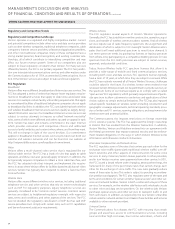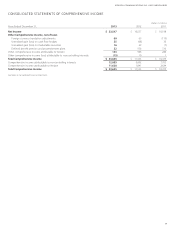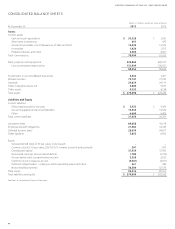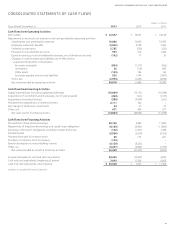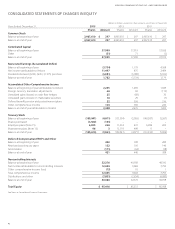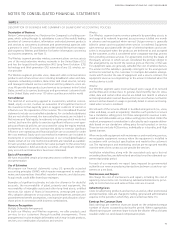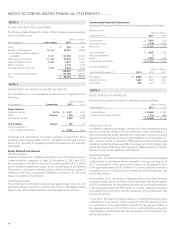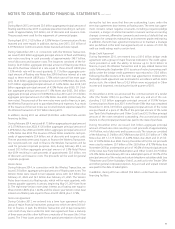Verizon Wireless 2013 Annual Report Download - page 46
Download and view the complete annual report
Please find page 46 of the 2013 Verizon Wireless annual report below. You can navigate through the pages in the report by either clicking on the pages listed below, or by using the keyword search tool below to find specific information within the annual report.44
NOTES TO CONSOLIDATED FINANCIAL STATEMENTS continued
There were a total of approximately 8 million, 9 million and 6 million
stock options and restricted stock units outstanding included in the
computation of diluted earnings per common share for the years ended
December 31, 2013, 2012 and 2011, respectively. Outstanding options to
purchase shares that were not included in the computation of diluted
earnings per common share, because to do so would have been anti-
dilutive for the period, were not signicant for the years ended December
31, 2013 and 2012, respectively, and included approximately 19 million
weighted-average shares for the years ended December 31, 2011.
As of December 31, 2013, we were authorized to issue up to 4.25 bil-
lion and 250 million shares of common stock and Series Preferred Stock,
respectively. On January 28, 2014, at a special meeting of our share-
holders, we received shareholder approval to increase our authorized
shares of common stock by 2 billion shares to an aggregate of 6.25 billion
authorized shares of common stock. On February 4, 2014, this authoriza-
tion became eective.
Cash and Cash Equivalents
We consider all highly liquid investments with a maturity of 90 days or
less when purchased to be cash equivalents. Cash equivalents are stated
at cost, which approximates quoted market value and include amounts
held in money market funds.
Marketable Securities
We have investments in marketable securities, which are considered
“available-for-sale” under the provisions of the accounting standard for
certain debt and equity securities, and are included in the accompanying
consolidated balance sheets in Short-term investments, Investments in
unconsolidated businesses or Other assets. We continually evaluate our
investments in marketable securities for impairment due to declines in
market value considered to be other-than-temporary. That evaluation
includes, in addition to persistent, declining stock prices, general economic
and company-specic evaluations. In the event of a determination that a
decline in market value is other-than-temporary, a charge to earnings is
recorded for the loss, and a new cost basis in the investment is established.
Inventories
Inventory consists of wireless and wireline equipment held for sale,
which is carried at the lower of cost (determined principally on either an
average cost or rst-in, rst-out basis) or market.
Plant and Depreciation
We record plant, property and equipment at cost. Plant, property and
equipment of wireline and wireless operations are generally depreciated
on a straight-line basis.
Leasehold improvements are amortized over the shorter of the estimated
life of the improvement or the remaining term of the related lease, calcu-
lated from the time the asset was placed in service.
When the depreciable assets of our wireline and wireless operations
are retired or otherwise disposed of, the related cost and accumulated
depreciation are deducted from the plant accounts, and any gains or
losses on disposition are recognized in income.
We capitalize and depreciate network software purchased or developed
along with related plant assets. We also capitalize interest associated with
the acquisition or construction of network-related assets. Capitalized
interest is reported as a reduction in interest expense and depreciated as
part of the cost of the network-related assets.
In connection with our ongoing review of the estimated remaining
average useful lives of plant, property and equipment at our local tele-
phone operations, we determined that there were no changes necessary
for average useful lives for 2013, 2012 and 2011. In connection with our
ongoing review of the estimated remaining average useful lives of plant,
property and equipment at our wireless operations, we determined that
changes were necessary to the remaining estimated useful lives as a
result of technology upgrades, enhancements, and planned retirements.
These changes resulted in an increase in depreciation expense of $0.4
billion in 2011. While the timing and extent of current deployment plans
are subject to ongoing analysis and modication, we believe the current
estimates of useful lives are reasonable.
Computer Software Costs
We capitalize the cost of internal-use network and non-network software
that has a useful life in excess of one year. Subsequent additions, modi-
cations or upgrades to internal-use network and non-network software
are capitalized only to the extent that they allow the software to perform
a task it previously did not perform. Planning, software maintenance and
training costs are expensed in the period in which they are incurred. Also,
we capitalize interest associated with the development of internal-use
network and non-network software. Capitalized non-network internal-
use software costs are amortized using the straight-line method over a
period of 3 to 7 years and are included in Other intangible assets, net
in our consolidated balance sheets. For a discussion of our impairment
policy for capitalized software costs, see “Goodwill and Other Intangible
Assets” below. Also, see Note 3 for additional detail of internal-use non-
network software reected in our consolidated balance sheets.
Goodwill and Other Intangible Assets
Goodwill
Goodwill is the excess of the acquisition cost of businesses over the fair
value of the identiable net assets acquired. Impairment testing for good-
will is performed annually in the fourth scal quarter or more frequently if
impairment indicators are present. The Company has the option to per-
form a qualitative assessment to determine if the fair value of the entity
is less than its carrying value. However, the Company may elect to per-
form an impairment test even if no indications of a potential impairment
exist. The impairment test for goodwill uses a two-step approach, which
is performed at the reporting unit level. We have determined that in our
case, the reporting units are our operating segments since that is the
lowest level at which discrete, reliable nancial and cash ow information
is available. Step one compares the fair value of the reporting unit (calcu-
lated using a market approach and/or a discounted cash ow method)
to its carrying value. If the carrying value exceeds the fair value, there is a
potential impairment and step two must be performed. Step two com-
pares the carrying value of the reporting unit’s goodwill to its implied fair
value (i.e., fair value of reporting unit less the fair value of the unit’s assets
and liabilities, including identiable intangible assets). If the implied fair
value of goodwill is less than the carrying amount of goodwill, an impair-
ment is recognized.
Intangible Assets Not Subject to Amortization
A signicant portion of our intangible assets are wireless licenses that
provide our wireless operations with the exclusive right to utilize des-
ignated radio frequency spectrum to provide wireless communication
services. While licenses are issued for only a xed time, generally ten years,
such licenses are subject to renewal by the Federal Communications
Commission (FCC). License renewals have occurred routinely and at nom-
inal cost. Moreover, we have determined that there are currently no legal,
regulatory, contractual, competitive, economic or other factors that limit
the useful life of our wireless licenses. As a result, we treat the wireless
licenses as an indenite-lived intangible asset. We reevaluate the useful
life determination for wireless licenses each year to determine whether
events and circumstances continue to support an indenite useful life.
We test our wireless licenses for potential impairment annually. In 2013,
we performed a qualitative assessment to determine whether it is more
likely than not that the fair value of our wireless licenses was less than
the carrying amount. As part of our assessment, we considered several
qualitative factors including the business enterprise value of Wireless,


